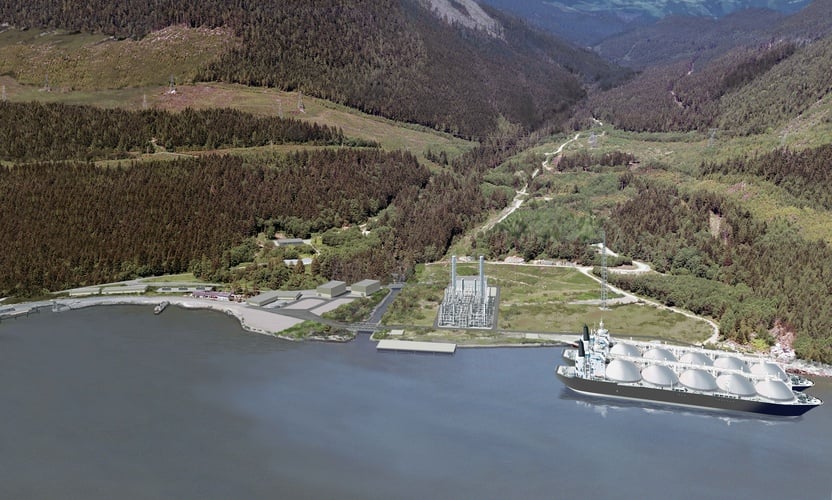For years, Nexen's Aurora project envisioned transforming Digby island near Prince Rupert into a sprawling $20 billion LNG plant shipping 24 million tonnes of liquified B.C. natural gas to Asia.
On Sept. 14, Aurora officially backed out, reinforcing the words written in this year’s NDP election platform. “[Ex-premier Christy Clark] bet everything on natural gas prices and left the rest of B.C.’s economy without support,” it reads. “Resource communities and families have paid the price. That’s got to change.”
But change to what? With the rise of B.C.’s new NDP government, forged with the support of the B.C. Greens under climate scientist Andrew Weaver, there is now an opportunity to reset and find more realistic ways to tap the wealth of natural gas in the Peace region. “The idea that there is going to be a big mega project like Petronas [Pacific NorthWest LNG] was nothing but a pipe dream,” says Weaver. “The real question is, what are we going to do with the resource?”
There are three B.C. LNG projects worth noting these days: Woodfibre, a small project near Squamish; Tilbury, a recently-expanded LNG facility in Delta operated by FortisBC; and LNG Canada, a big project at Kitimat led by Shell, which continues to delay a final investment decision.
For the short term the economics of new LNG are nonexistent, but in the medium term, things could improve: Bloomberg New Energy Finance’s latest global LNG outlook points to a current oversupply, with supply and demand projected to match again around 2024. After that, new supply could be needed.
When and if the that time comes, the NDP has issued four vague conditions that new projects will have to meet. Proposals must provide a fair return for the resource, include local job guarantees and training, First Nations partnerships, and protection for the environment — including “living up to our climate commitments.”
The B.C. Ministry of Energy, Mines and Petroleum Resources refused interview requests and would not provide additional information about the conditions — or other key aspects of NDP election promises pertaining to natural gas.
And as for Christy Clark’s Prosperity Fund from LNG windfalls which was projected to eventually hold $100 billion, the NDP during the election promised to drain the fund and use it to fund the cutting of two Lower Mainland bridge tolls.
The amount of natural gas extracted in B.C. continues to go up — in spite of current low gas prices and the short-term death of LNG.
Today this growing production reaches three primary markets: Alberta, where much of it is used to create steam for in situ bitumen mining in the oilsands; the U.S., where some is shipped as LNG out of Louisiana; and finally, for domestic use in British Columbia.
Virtually all current (and future) production will involve hydraulic fracking — an energy-intensive process where enormous quantities of water, sand and chemicals are forced under high pressure into horizontal wells to release natural gas trapped in the rock.
Back during the election campaign, the NDP promised to conduct a scientific review of fracking. The province did not provide details about the review for this story, but Ben Parfitt, a Canadian Centre for Policy Alternatives resource policy analyst — who has documented the use of illegal dams by the gas industry to provide water for fracking — says such a review is warranted.
Parfitt points to an August 2015 incident where a B.C. fracking site operated by Progress Energy is believed to have triggered a 4.6 magnitude earthquake — among the biggest earthquakes by a natural gas industry drilling-fracking operation anywhere, ever. Progress’ own data later showed that this operation used about eight times the volume of water used in a typical U.S. fracking operation.
“If we ever saw a major LNG facility open on our coast, then the level of drilling and fracking would increase by a very significant factor. The water demand would go up exponentially,” Parfitt said.
It’s relevant that the annual meeting of the Union of B.C. Municipalities last month included a vote on a B.C. moratorium on fracking. B.C. Green Party leader Weaver doesn’t favour this approach, but says we need to find a way to manage the “cumulative impacts” of our current “wild west” approach to resource extraction. “Nobody is saying ‘stop producing natural gas,’ but under the Liberals it was a get-to-yes approach.”
To that end the Greens have proposed creating a natural resources board that could oversee and manage the many cumulative impacts of resource development. He points to the “patchwork” approach to protecting caribou as an example of the current dysfunction.
“We have roads going in here, forestry there, mining here and natural gas there. There is no overarching look at how we can develop our resources in a manner that is sustainable in the long term,” Weaver said.
“That’s what we are looking for.”
A bright spot for B.C. natural gas, says Tyler Bryant of FortisBC, is to use it in B.C. to substitute the use of marine diesel and heavy fuel oil in ferries and ships, and diesel in transport trucks.
FortisBC recently expanded its Tilbury LNG facility at Delta — which today supplies fuel for five passenger ferries operated by B.C. Ferries and two cargo ferries for Seaspan. Since 2011, it has provided incentives to convert more than 700 natural gas vehicles in B.C. — which the company says has saved 135,000 tonnes of carbon dioxide and $20 million in fuel costs to date.
Tyler says natural gas makes it possible to address difficult to “decarbonize” sectors like shipping and trucking — and allows us to use a B.C. resource that has lower carbon dioxide emissions. To critics who want cleaner alternatives sooner, he says natural gas can be viewed as a bridge.
“We have an option to reduce GHGs and local air pollution right now with natural gas. And in 10 years time when you have to replace the vehicles, if other technologies are available, then we can explore those options.” On the day I talk with Andrew Weaver about natural gas, he’s on speakerphone driving a broken microwave to a Victoria-area recycling depot.
“Government has a role to play in this,” he says of substituting natural gas for dirtier fuels. He is cut short when a transport truck passes and blasts him with fumes. “If that guy had been using compressed natural gas instead of diesel, that wouldn’t have happened,” he laughs.
Weaver says fuel switching using natural gas to displace emissions from ships and trucks is an opportunity we need to capitalize on in B.C.
One way to get there, he adds, is by pricing emissions via the newly invigorated B.C. carbon tax — which will be rising from the current $30 to $50 tonne by 2021.
By making it more expensive to operate higher-polluting vehicles, Weaver says the tax has the power to drive society to lower-emitting transportation. In the deliberations between Greens and the NDP, Weaver says it was vital to give B.C. industry “certainty” around how the carbon tax would be increased — so they pushed for the price to increase by $5 a year staring in 2018, and will reach Canada’s national target (of $50 a tonne) by 2021 — a year ahead of the national schedule.
The newly strengthened carbon tax will also force the gas-patch to clean up a lot of emissions it has not had to pay for — up to now.
In the MOU signed between the Greens and NDP, a commitment was also made to broaden the carbon tax to capture so-called “fugitive” emissions — a catch-all phrase for carbon dioxide and methane emissions that occur during gas extraction and processing.
Maximilian Kniewasser, program director of B.C. Climate Policy at the Pembina Institute, says such emissions occur when industry vents carbon dioxide that is extracted with natural gas, as well as from methane escaping from pumps and controls in processing plants and pipelines. There are also the leaks that occur among many moving parts working under pressure.
Capturing these emissions dovetails with Canada’s commitment to reduce emissions by 45 per cent from oil and gas by 2025, says Kniewasser.
The hard part, he concedes, will be to agree on a way to quantify the amounts of “fugitive” gases escaping into the atmosphere.
Curtailing fugitive emissions is one important part of making domestic use of natural gas feasible from a climate perspective but, according to Weaver, the world is on a transition path away from fossil fuel use.
“We are in the middle of an energy revolution like we’ve never seen before,” Weaver said. “To think that, somehow, we are going to continue to produce energy the way we were is a bit of a myth.” ![]()
Read more: Energy
















Tyee Commenting Guidelines
Comments that violate guidelines risk being deleted, and violations may result in a temporary or permanent user ban. Maintain the spirit of good conversation to stay in the discussion.
*Please note The Tyee is not a forum for spreading misinformation about COVID-19, denying its existence or minimizing its risk to public health.
Do:
Do not: